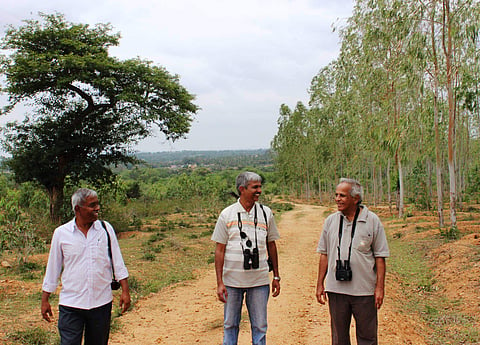

Who doesn't know Mysuru, a city known for its heritage, culture and food? But this time, the city has got something even better associated with it. Now, the Mysureans can be proud to have a Bird Atlas specially for their city. Like any other bird atlas, this one will describe the different species of birds which are native to Mysuru and also migrate from different parts of the world.
According to the birders who worked for the Bird Atlas project, there are 1,300 species of birds in India and at least 192 species are available in Musuru. "This number will vary as per the seasons here. During Summer, we get to see 105 species which includes both migratory and native species. During winters, we get to see 130 different species of the migratory birds," says Shivaprakash Adavanne, who leads the project.
Shivaprakash is an engineer by profession and has been into bird watching for many years. Explaining how the idea came about, he says, "Many developed countries already have their bird atlases but this is the first bird atlas in India. The idea came to us when Sálim Ali Centre for Ornithology and Natural History (SACON) in Coimbatore organised a seminar a few years ago and the concept of a bird atlas was discussed there. I along with other bird watchers in Mysuru decided to implement it in our city and create a bird atlas. A team of 60 people was formed to go bird watching and document it along with the names, pictures etc. That was in 2014."
Though Mysuru is not as huge as Bengaluru, it took a lot of time for each bird watcher to look for birds and document them with proper details. He says, "The total area of Mysuru city is 160 sq km. We divided the city into 132 grids. Here, the grids refer to different places. Each grid measures 1.1 x 1.1 km. And for every grid, there are particular people who look for birds. For example, if one person takes care of N R Mohalla, another person look for birds in Kuvempu Nagar and its surrounding areas." He went on to add that they did this over and over again till the whole of Mysuru was covered, "We had to follow the same process for consecutive three years. The volunteers would go bird watching for all the thirty days especially early in the morning and in the evening hours as we get to see more birds during this part of the day."
After completing the project, they submitted it to Suhel Quader who works with the Nature Conservation Foundation. He took on the responsibility of putting all this data together in the form of atlas. "There is a particular software in which our data is stored and categorised as per the format needed to publish it in the form of the atlas," he adds.
What did they learn along the way?
Shivaprakash and his team not only found the species and their names, but they were able to draw comparisons based on data from previous years as to when a particular species comes. As expected, the number of species recorded in winter is higher when compared to summer
He further explains, "Have you heard of the Purple Rumped Sun Bird? You get to see this particular species only in the month of June or during the rainy season. In contrast, the Black Drongo can be seen mostly in February but disappears completely in the month of June. The Grey Wagtail which is a long-distance migratory bird disappears only in the month of June," he rattles off trivia.
He even uses the data gathered to talk about a contemporary bird issue that has troubled some of us, "We all have spoken about a decrease in the population of sparrows. During this project, we were able to understand that the species of sparrows have moved to different places and not decreased. While we were trying to search for them in places where there are more trees and water, sparrows were found in locations where there was little disturbance to create their habitat and find their food. It is the change in lifestyle, climate and other factors which may have led the birds to move to different places," he surmises.
Some notable birds found in Mysuru in migration season!
Common Myna, Black Kyte, Rose Ringed Parakeet, Blue Rock Pigeon, Large Billed Crow, Asian Koel, Ashy Prinia, Spotted Dove, Greater Coucal, Red Vented Bulbul, House Crow, Red Whiskered Bulbul, Jungle Myna, Black Drongo, Cattle Egret, Pale Billed Flowerpecker, Pied Bushchat, Purple Sunbird, Purple Rumped Sunbird, Jungle Myna
